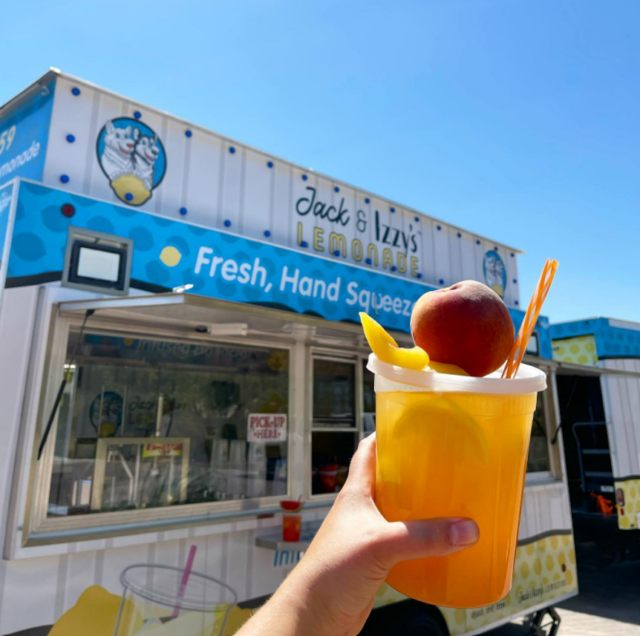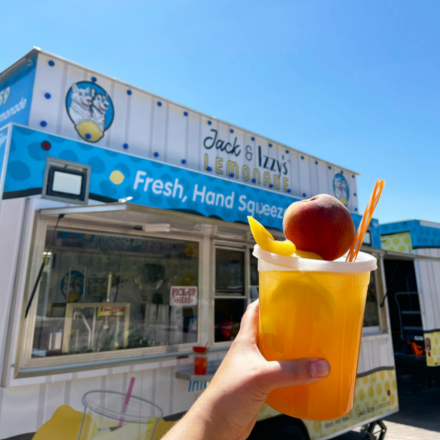By Russ Banham
After a long career in pharmaceutical manufacturing, Jonathan Post wanted to do something different with the rest of his life. At first, he thought he’d open a brick-and-mortar restaurant but decided the business was too risky and time-consuming. He launched a lemonade stand instead. On wheels.
Jack & Izzy’s Lemonade, named for Post’s two huskies, is a custom-built food truck that sells 60 different flavors of lemonade that are handmade to order. Using an air-compressed pneumatic wedge, Post and three employees squeeze thousands of fresh organic lemons at 100 psi to make over 500 lemonades in less than three hours. Aside from the quality of his product, Post says his truck’s “high-tech gizmos” have made Jack & Izzy’s a profitable business. “I’ve got a touch-screen kiosk from Infi that looks like a giant 24-inch by 15-inch screen smartphone that I set up at festivals so people can order without waiting in line,” he says.
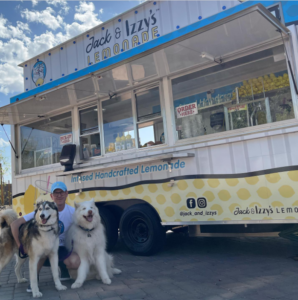
That’s just one gizmo. Post also has an advanced point of sale (POS) system from Square Analytics with reporting and analytics capabilities, as well as the traditional sales processing. Reports on gross sales, net sales and discounts are presented, along with sales trends, items sales (how many people bought strawberry lemonade versus blueberry lemonade), and sales tax information, based on the state that Jack & Izzy’s Lemonade is stationed. “I easily print out the detailed quarterlies to send to my accountants,” he says.
Post splurged on the food truck’s design to stand out at festivals and other events. It was built from scratch with an 18-foot-long window so customers can enjoy a choreographed dance as he and his staff “smash lemons” with the pneumatic wedge (“I’m the chief smasher,” he says).
He also invested in a custom-made, digital menu inside a 70-inch high-definition television monitor that he mounted on a wheeled platform, which he rolls out of the truck to display each day’s menu of lemonade flavors. “I can instantly change the menu on my laptop to reflect the type of event, such as a rodeo or a music festival,” says Post. “It’s specially made by ElectroMenu to be seen in daylight and includes the most amazing graphics.”
Mark Evans, ElectroMenu founder and CEO, says he was inspired “by old-fashioned sandwich signs, where you changed the menu and prices daily.”
To do just that, Post plugs a laptop into the menu board with an HDMI cable. ElectroMenu’s built-in menu templates instantly appear, along with “authoring tools” used to select one of hundreds of menu designs, each aligning with the theme of a particular event.
“Depending on the need, there are all sorts of videos, static images and animations that make the menu more interesting to capture the customer’s attention,” Post says, citing his personal favorite: an animated video of “a guy running around with a BBQ grill spewing fire.”
Big small business
Welcome to today’s food truck industry, a business composed of smaller vendors like Jack & Izzy’s Lemonade and major corporate players with multiple food trucks hawking diverse fare, from prosaic hot dogs and tacos to culinary delights like crepes and pickled shrimp. Approximately 24,000 food trucks are active in the U.S., according to estimates made by Smallbizgenius, a digital community.
During the early months of the pandemic, when traditional restaurants were closed due to indoor social distancing mandates, many food trucks (or mobile food vendors, as the businesses are formally known) stayed open to serve customers outdoors.
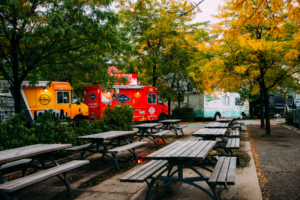
Ross Resnick, founder and CEO of Roaming Hunger, an 11-year-old online food truck booking service, says his bookings slowed considerably at the pandemic’s outset but took off from there. “Once it was clear there was less risk to becoming infected outdoors, it just exploded; people were yearning for communal experiences,” Resnick says.
In 2010, when he came up with the idea for the Roaming Hunger app, which makes it easy for event planners to locate and schedule a food truck, the industry has rapidly evolved. “It’s become much easier these days to operate a food truck as a profitable business,” he says. “When we started, we could find only around 300 vendors that were known for their quality and brand, and now there are 20,000 of them.”
Roaming Hunger’s services have evolved along with the industry. In the company’s early years, its business model was predicated on helping event planners track down food trucks; in 2014, it flipped the paradigm to help vendors track down event planners instead. “Our platform lets vendors create unique menus to bid on an upcoming festival or a block party; the host then selects the vendor that best fits their food and budget,” says Resnick, noting that Roaming Hunger adds a small booking fee to the pricing package.
It’s become much easier these days to operate a food truck as a profitable business. When we started, we could find only around 300 vendors that were known for their quality and brand, and now there are 20,000 of them.
—Ross Resnick, founder and CEO of Roaming Hunger
The cost to operate a food truck is less than launching a brick-and-mortar restaurant that requires monthly expenses for rent and utilities to keep environs well-lit, air-conditioned and heated. Plus, the growing range of custom-made kitchen appliances and high-tech business apps make it easier to sell more items faster and reduce the typical burdens of running a business, Resnick says.
“Food trucks were late adopters of technology, largely because they’re small enterprises and tech wasn’t cheap back then,” he notes. “Nowadays, many vendors have invested in cloud-based point of sale systems, digital displays, and even automated robots that make and knead pizza dough, for example, driving down labor costs.”
Tech-fueled trucks
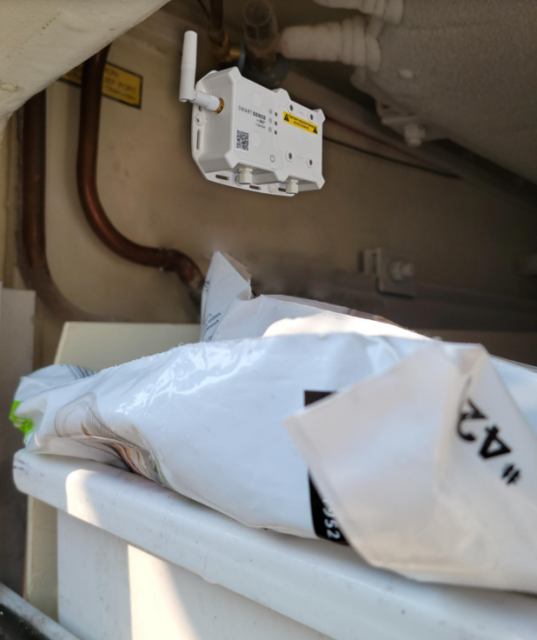
Other technologies also have made it easier and more profitable to operate a food truck as a business. For example, dozens of POS solutions, such as ShopKeep, TouchBistro, and Toast (in addition to Square Analytics) are available to process sales. And a variety of GPS-enabled fleet apps like Samsara and Azuga help owners of multiple food trucks track where each vendor is located.
To ensure food is fresh and properly stored, internet-enabled digital solutions with local area wireless (LAN) network capabilities like SmartSense provide continuous temperature and humidity readings. “We offer 24/7 monitoring to ensure proper refrigeration or freezing of food for safety reasons,” says Steve Habermas, chief technology officer of SmartSense, a business unit inside publicly-traded Internet of Things (IoT) pioneer Digi International.
Habermas explains that the solution helps vendors track and report temperatures to comply with the food industry’s Hazard Analysis Critical Control Point (HACCP) principles, a systematic approach to ensure food is safe from biological, chemical and physical hazards at all stages of the value chain, such as food preparation and distribution.
“Any business involved with providing food to the public must process a series of checklists and provide these reports to compliance inspectors, which was done with pen and paper,” he says. “Using IoT-enabled sensors, we’ve digitized what has heretofore been a manual process.”
The sensors transmit detailed temperature and humidity data every 10 or 15 minutes throughout the day, providing “definitive knowledge” that food remains fresh and safe to consume, he says. “The data goes from the local sensor to our cellular gateway, where it passes into our cloud platform; if the readings indicate a problem, an alarm is activated, and the customer is immediately notified,” Habermas adds.
Other burgeoning concepts include experiments with fully automated food trucks offering contactless services to customers that virtually eliminate hygiene risks. At Huli Innovation Park in Xiamen, China, for example, a pilot project is underway involving four artificial-intelligence-powered unmanned food trucks supported by 5G broadband networks. Users scan a QR code on the automated food truck with their smartphones to order up to 200 breakfasts and 11 lunches or dinners.
Any business involved with providing food to the public must process a series of checklists and provide these reports to compliance inspectors, which was done with pen and paper. Using IoT-enabled sensors, we’ve digitized what has heretofore been a manual process.
—Steve Habermas, CTO of SmartSense
In 2019, robots directed by over 100 different sensors made a variety of organic smoothies in an experimental food truck at Venice Beach in Los Angeles launched by Ono Food Company (recently rebranded as Hyphen). Customers could order and pay in advance for smoothies using their smartphones; when they got to within 300 feet of the truck, the GPS-enabled smartphone alerted the robots to start whipping up the smoothie in self-cleaning blenders. The success of the project guided Hyphen in commercializing a line of automated restaurant kitchens.
Asked if he might be interested in turning his lemonade stand on wheels into an automated robot-run enterprise in the future, Post laughs. “Are you kidding? I’m having too much fun,” the former pharmaceutical manufacturing rep says.
“Last Friday, we were at a festival in Sedona, Arizona, and we made 825 handmade lemonades in five hours, a record. It was a blast. I’m now thinking about investing in another truck—Jack & Izzy’s Donuts.”
His huskies would like that.
Lead photo courtesy of Jack & Izzy’s
